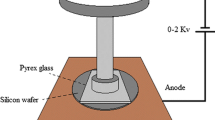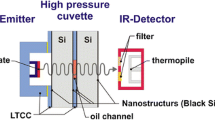Abstract
In this paper, an Otto coupling configuration based SPR chip is designed, simulated and fabricated using a silicon-on-quartz (SoQ) bonding process. The simulation of the SPR effect is conducted using COMSOL Multiphysics simulator (Altsoft Co.) using the designed chip dimensions, the optical constants are interpolated from data available in the literature. The size of the fabricated SPR chip is \(30\; \times \;30\; \times \;1 {\text{mm}}^{3}\). Resonance angle and reflectance are measured to be 42.19° and 0.411°, respectively, using an automated reflectometer. Discrepancy between measurement and simulation results is discussed by optical constant of the gold layer used as a thin metal film. The SoQ bonding process is a feasible approach for implementation of Otto coupling configuration based SPR chips.













Similar content being viewed by others
References
Boreman GD, Johnson T, Jones AC, Oh SH, Olmon RL, Raschke MB, Shelton D, Slovick B (2011) Broadband electrical permittivity of gold for plasmonics and nano-optics applications. In: 2011 Conference on Lasers and Electro-Optics, 1 (CLEO 2011)
Babar S, Weaver JH (2015) Optical constants of Cu, Ag, and Au revisited. Appl Opt 54:477–481
Cesaro-Tadic S, Dernick G, Juncker D, Buurman G, Kropshofer H, Michel B, Fattinger C, Delamarche E (2004) High-sensitivity miniaturized immunoassays for tumor necrosis factor using microfluidic systems. Lab Chip 4:563–569
Chen WP, Chen JM (1981) Use of surface plasma waves for determination of the thickness and optical constants of thin metallic films. J Opt Soc Am 71:189–191
Elbel N, Behner H, Seggen HV (1995) Preparation and characterization of epitaxial gold films deposited on mica by direct current magnetron sputtering. J Vac Sci Technol B 13(5):2119–2123
Flanagan MT, Pantell RH (1984) Surface plasmon resonance and immunosensors. Electr Lett 20:968–970
Fontana E, Cavalcanti GO (2013) Maintaining a stationary laser footprint during angular scan in internal-reflection experiments. Appl Opt 52:7669–7674
Fontana E, Pantell RH (1988) Characterization of multilayer rough surfaces by use of surface-plasmon spectroscopy. Phy Rev B 37:3164–3182
Fontana E, Pantell RH, Strober S (1990) Surface plasmon immunoassay. Appl Opt 29:4694–4704
Fontana E, Kim JM, Llamas-Garro I, Cavalcanti GO (2015) Microfabricated Otto chip device for surface plasmon resonance-based optical sensing. Appl Opt 54:9200–9204
Gao L, Lemarchand F, Lequime M (2011) Comparison of different dispersion models for single layer optical thin film index determination. Thin Solid Films 520:501–509
Henmi H, Shoji S, Shoji Y, Yoshimi K, Esashi M (1994) Vaccum packaging for microsensors by glass-silicon anodic bonding. Sens Act A 43:243–248
Hoa XD, Kirk AG, Tabrizian M (2007) Towards integrated and sensitive surface plasmon resonance biosensors: A review of recent progress. Biosens Bioelectron 23:151–160
Homola J, Yee S, Gauglitz G (1999) Surface plasmon resonance sensors: review. Sens Actuators B Chem 54:3–15
Hoogvliet JC, Van Bennekom WP (2001) Gold thin-film electrodes: an EQCM study of the influence of chromium and titanium adhesion layers on the response. Electrochim Acta 47:599–611
Kretschmann E (1981) The Determination of the Optical Constants of Metals by Excitation of Surface Plasmons. Z Physik 241:313–324
Levin M, Lasskso A, Niemi HE-M, Hautojärvi P (1997) Evaporation of gold films on mica: effect of evaporation parameters. Appl Surf Sci 115:31–38
Lide DR (2005) CRC Handbook of Chemistry and Physics. 85th edn. CRC press, p 2712
Liedberg B, Nylander C, Lundsrom I (1983) Surface plasmon resonance for gas detection and biosensing. Sens Actuators 4:299–304
Liedberg B, Lundstrom CI, Stenberg E (1993) Principles of biosensing with an extended coupling matrix and surface plasmon resonance. Sens Act B 11:63–72
Olmon RL, Slovick B, Johnson TW, Shelton D, Oh SH, Boreman GD, Raschke MB (2012) Optical dielectric function of gold. Phys Rev B 86:235147
Otto A (1968) Excitation of nonradiative surface plasma waves in silver by the method of frustrated total reflection. Z Physik 216:398–410
Rakić AD, Djurišić AB, Elazar JM, Majewski ML (1998) Optical properties of metallic films for vertical-cavity optoelectronic devices. Appl Opt 37:5271–5283
Semaltianos NG, Wilson EG (2000) Investigation of the surface morphology of thermally evaporated thin gold films on mica, glass, silicon and calcium fluoride substrates by scanning tunneling microscopy. Thin Solid Films 366:111–116
Sjolander S, Urbanicczky C (1991) Integrated fluid handling system for biomolecular interaction analysis. Anal Chem 63:2336–2345
Suga T, Kim TH, Howlader MMR (2004) Combined process for wafer direct bonding by means of the surface activation method. Proc 54th IEEE Electr Comp Technol Conf 1:484–490
Toigo F, Marvin A, Celli V, Hill NR (1977) Optical properties of rough surfaces: General theory and the small roughness limit. Phys Rev B 15:5618–5626
Wallashi AJ, Levit L (2003) Electrical breakdown and ESD phenomena for devices with nanometer-to-microngaps. Proc. SPIE 4908:87
Wood RW (1902) On a Remarkable Case of Uneven Distribution of Light in a Diffraction Grating Spectrum. Proc Phys Soc Lond 18(4):269–275
**ang Q, Hu C, Gao Y, Li D (2006) Miniaturized immunoassay microfluidic system with electrokinetic control. Biosens Bioelectron 21:2006–2009
Acknowledgments
This work was supported by FACEPE-Brazil (APQ112030410), CNPq-Brazil (56066520105), the Spanish Ministry of Economy and Competitiveness project PIB2010BZ-00585 and NRF–Korea (NRF–2013K2A1A2049144, NRF-2014R1A1A2055653) part of this work has been supported by the Generalitat de Catalunya under Grant 2014 SGR 1551.
Author information
Authors and Affiliations
Corresponding authors
Additional information
J.-M. Kim and E. Fontana contributed equally.
Rights and permissions
About this article
Cite this article
Lee, Y., Sim, Sm., Fontana, E. et al. Silicon-on-quartz bonding based SPR chip. Microsyst Technol 23, 1983–1989 (2017). https://doi.org/10.1007/s00542-016-2960-x
Received:
Accepted:
Published:
Issue Date:
DOI: https://doi.org/10.1007/s00542-016-2960-x




